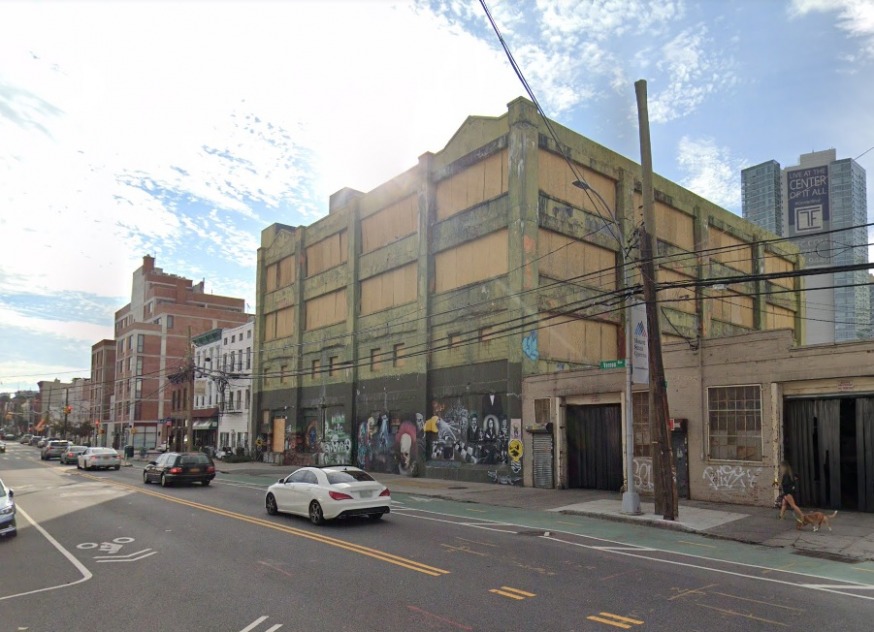
The Paragon Paint building at 45-40 Vernon Blvd. A developer seeks a zoning variance in order to develop a 23-story residential tower on the site (GMaps)
May 10, 2022 By Christian Murray
A development company plans to build a 23-story residential tower on Vernon Boulevard—on the site that is currently home to the dilapidated Paragon Paint Building.
Quadrum Global, an international investment firm, is seeking a zoning variance through the Board of Standards and Appeals (BSA) in order to develop the property that would involve rehabilitating the Paragon Paint building at 45-40 Vernon Boulevard and developing a 23-story tower behind it.
Jeff Mulligan, a land use attorney with Kramer Levin, presented Quadrum’s plan to Queens Community Board 2 Thursday looking for the board to support its application for a variance. The board did not vote on the plan, with a vote scheduled for June 2.
The project, Mulligan said, would consist of 226 dwelling units and ground floor retail space. The project would also include public access space that would go from Vernon Boulevard through to Anable Basin. Approximately 20 percent of the site would be dedicated for open space.
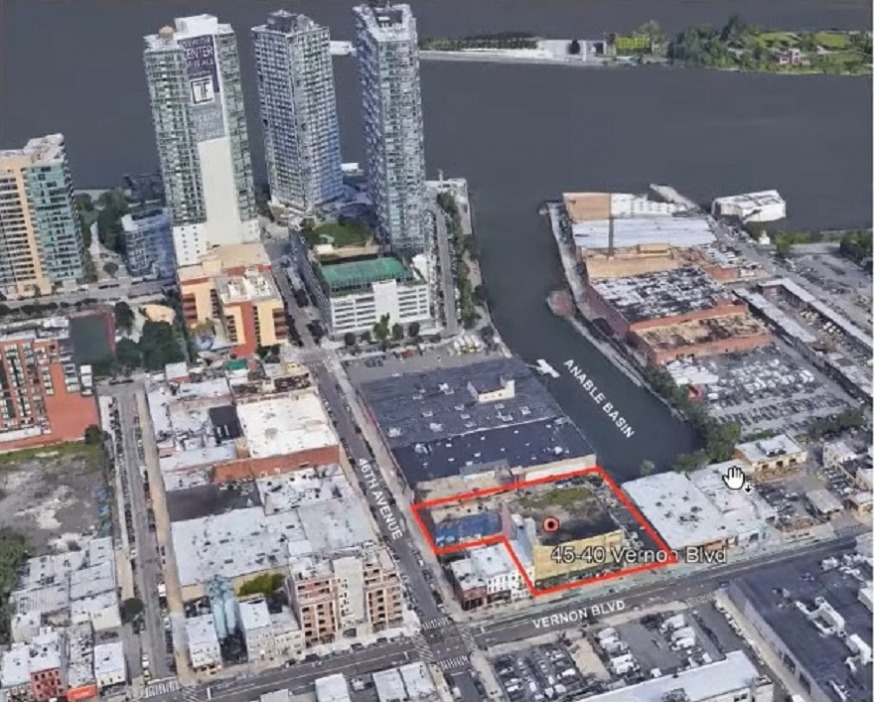
The Paragon Paint development site is marked in red (Screenshot of presentation)
The site is zoned for manufacturing and Quadrum needs a variance to permit residential use. The site also needs a zoning change to permit a 262-foot-tall tower– which is well above the maximum height limit of 150 feet. The proposed development also doesn’t comply at present with some set back provisions, and the building envelope is larger than what current zoning permits.
An application for a variance was originally filed with the Building Standards & Appeals in 2015 but was put on hold. The plan was shelved since the site was included as part of the now-scuttled YourLIC proposal, an unsuccessful plan put forward by a number of developers that aimed to rezone 28 acres around Anable Basin.
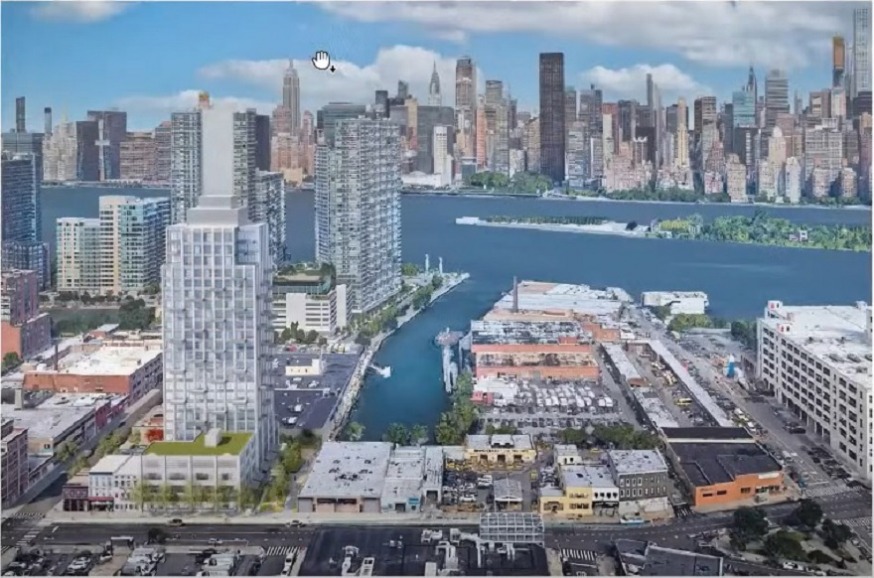
Rendering of the 23-story building. The building is located on the lefthand side tucked behind a revamped Paragon Paint building. (Screenshot of presentation)
There are only two ways that developers, such as Quadrum, can get a site rezoned—either through the BSA or via City Planning’s traditional ULURP process.
The BSA track, which is a less cumbersome process, can only be taken if special criteria are met. Most developers, however, don’t meet the special criteria so they undergo the seven-month ULURP process.
To meet the BSA criteria, developers must prove that their property has a unique physical condition that poses a financial hardship—and hence the need for a variance.
Quadrum is claiming that the cost of cleaning up the toxic site has caused an economic hardship. The company says that it has spent $13 million remediating the site, which has involved clearing the contaminated soil, treating the ground water, as well as replacing the timber bulkhead/seawall that touches Anable Basin.
The developer argues that it needs a variance to offset the cost of the environmental cleanup. The company says that it was costly since the site was home to a paint factory where millions of gallons of paint and varnish were processed each year, with industrial materials leaking all over the site and into the river.
The BSA also stipulates that it will not approve an application for a variance if the proposal would change the character of a neighborhood.
The developer argues that the project is not out of character with the neighborhood, saying that it is in context with nearby waterfront developments. Furthermore, they argue, the tower is set back 80 feet from Vernon Boulevard, so it is not out of character with the smaller buildings on Vernon Boulevard.
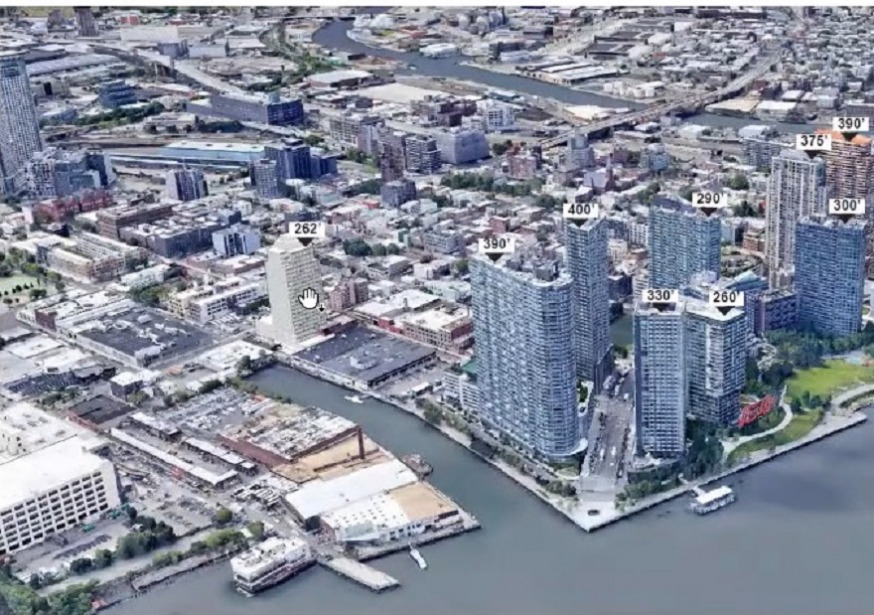
The proposed tower would be 262 feet tall. The rendering shows how tall it would be relative to the towers by the East River (screenshot)
The BSA also stipulates that the financial hardship must not have been created by the owner or a predecessor in title.
The board challenged Quadrum, questioning whether there was a true hardship, with members also saying that the project would alter the characteristics of the neighborhood.
Several board members said that Quadrum knew when it bought the site that it was contaminated so the hardship was self-imposed.
“You got into it with your eyes wide open,” said Kenneth Greenberg, a board member, noting that the Quadrum is a sophisticated developer.
Board members also said that the $13 million hardship would be more than offset through the variance. Furthermore, they noted that more than a quarter of the $13 million remediation costs would be subsidized through tax credits provided by the New York State Brownfield Cleanup Program.
A representative of the developer provided the board with financial data outlining why a variance was needed to offset the $13 million cost. However, the data was greeted with skepticism by several board members since they were unable to tell how it was generated, and methodology used to determine the profit and loss.
Lisa Deller, co-chair of CB2’s Land Use and Housing Committee, said that the development would offer little for the community—especially in comparison to the benefit the zoning variance would provide to the developer.
She said that the community appreciated that the site had been cleaned up—and that there would be public access from Vernon Boulevard to the Anable Basin—but argued that the community would be getting little else.
Deller also claimed that the developer did not meet the special criteria set by the BSA.
She said that the project is out of character to the immediate area which she said is low rise housing and light manufacturing. She insisted that the plan would alter the essential character of the area.
“The community is not getting much other than more gentrification and more density and more stormwater,” Deller said.
Christine Hunter, also a co-chair of the Land Use and Housing Committee, agreed with Deller:
“Light industry and arts—that is what this neighborhood is known for,” she said. “I don’t think it [the development] is appropriate.”
The plan, however, does have the support of local business groups such as the Long Island City Partnership and the Queens Chamber of Commerce.
Charles Yu, senior director of business assistance with the LIC Partnership, told the board that the project would bring much needed open space and provide access to the waterfront.
Meanwhile, Brendan Leavy, the business development manager with the Queens Chamber, advocated for the plan and complimented the developer for ensuring that the lower-density component of the project was closer to Vernon Boulevard, with the tower by the water.
He noted that the development is smaller compared to the original 2015 BSA application. The tower in the original plan was slated to be 290 feet tall and set back 37 feet from Vernon boulevard.
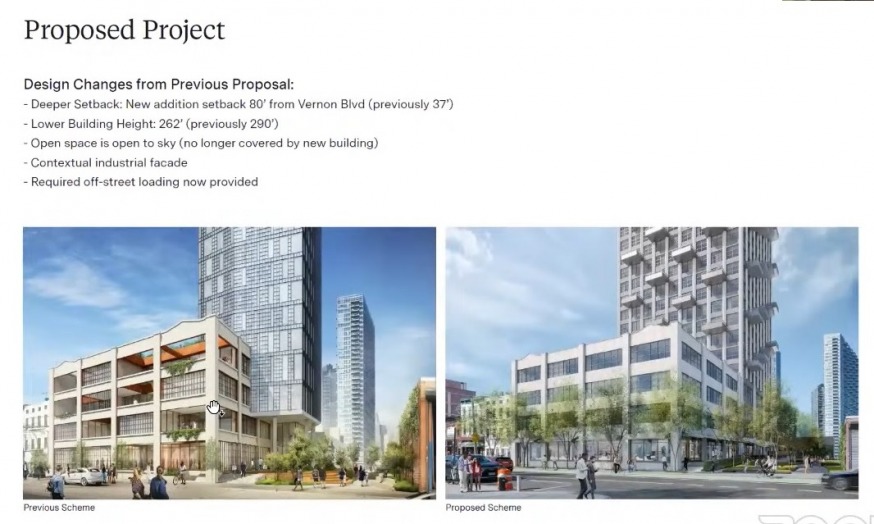
The changes made from the original plan (Screenshot of presentation)
However, many local residents told the Community Board that they opposed the plan.
Lisa Goren, a Long Island City resident who spoke during the meeting, urged the community board to reject the proposal. “It alters the essential character of the neighborhood,” she said.
Diane Hendry, a long-time resident, also said that it was out of character. “It is widely out of context,” she said, saying that it would go up next to one- and two-story buildings.
She said the cost of remediation is also miniscule in relation to the overall cost of the project and revenue that would be generated.
“These costs are a tiny fraction of the profit that will be made if this is approved,” Hendry said.
She urged the community board to reject it and to send a representative with legal expertise to the BSA to refute the developer’s arguments.
The variance, however, is not dependent on the approval of the community board, with its vote merely advisory.
The plan, given that it’s a BSA application, will not have to go before the borough president, City Planning Commission or City Council for a vote like with ULURP.
It will go straight from the community board to the BSA, where the BSA will render a decision.

Site plan (Screenshot)
2 Comments

when is enough going to be enough? who occupies all these apartments? the majority of people cannot afford them, in addition to all the reasons cited by L Penner – stop!
The continued economic success of new business and residential development coming to waterfront neighborhoods is dependent upon not only additional transportation capacity, but capital improvements to sewer, water, electrical and utility assets as well. Municipal fire, schools, library, police and sanitation services will also have to be expanded. What is the cost and who will pay for all these additional capital improvements and services? There is a good case to be made that both Long Island City and Hunters Point have reached the saturation point for any more new development.
(Larry Penner is a transportation advocate, historian and writer who previously worked for the Federal Transit Administration Region 2 NY Office.)